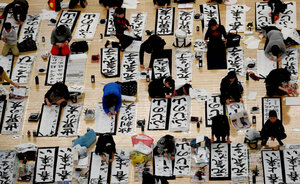Learning math is easier in some languages
I have been struck by how precisely Japanese encodes the base-10 number system used by most cultures around the world.

Attendees participate in a New Year calligraphy contest in Tokyo, Japan, on Jan. 5, 2019.
Kim Kyung-Hoon/Reuters
My family is planning a trip to Japan, and I’m trying to learn a bit of the language before we go. The textbook I bought begins by teaching counting, and I have been struck by how precisely Japanese encodes the base-10 number system used by most cultures around the world. When my children were learning math in elementary school, they spent a long time working on place value, gaining an intuitive understanding that, for example, 4,596 is made up of 4 thousands, 5 hundreds, 9 tens, and 6 ones. The Japanese word for this number makes it perfectly clear: yon sen go hyaku kyuu juu roku, or “4 thousand, 5 hundred, 9 ten, 6.”
English is pretty good at highlighting our decimal number system, too, but sometimes it muddies the waters. The words ninety and fifty resemble “nine tens” and “five tens,” but there’s just enough difference to obscure the connection. The teens are even worse. Logically, seventeen and eighteen should be “teen seven” (or even better, “ten seven”) and “teen eight,” just as they are in Japanese (juu nana and juu hachi). And don’t get me started on eleven (juu ichi, or “10+1” in Japanese).
I started to wonder, does this clear correspondence make it easier for children to learn math in Japanese? Karen Fuson and Yeping Li, professors of math education, argue that it does. Their studies have shown that numeracy (fluency with numbers and arithmetic) is easier to achieve in languages where numbers are “more transparent” in announcing their place value. Japanese is not the only language to reflect the base-10 system so clearly – Chinese, Korean, and Turkish do as well.
While English-speaking children still learn math perfectly well, words for numbers like eleven, seventeen, and fifty are stumbling blocks. “These may seem like small issues,” says Professor Fuson, “but the additional mental steps needed to solve problems cause more errors and drain working memory capacity.”
What then of French? If you’ve learned any of this language, you probably remember that something weird happens to numbers when you approach 100. The 60s are just fine, quite parallel to English in fact. We say “sixty-four” and the French say soixante-quatre (60+4). But in France 74 is not septante-quatre (70+4), it is soixante-quatorze (60+14). And “ninety-six” is the whopping quatre-vingt-seize, which translates to “four 20s+16.” These numbers are relics of an older number system, probably Celtic, that counted by 20s instead of by 10s. Studies have shown that French children are slower to acquire numeracy than their English-speaking counterparts, perhaps as a result of this holdover.
Whatever our language, we learn math eventually. The process, though, starts out easier for some than for others.

